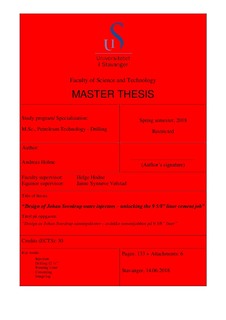| dc.description.abstract | For the injection wells on Johan Sverdrup, cementing operations concerning the 9 5/8’’ liners are extraordinarily critical. Complications like equipment malfunction, losses, and lost rotation, both during circulation and displacement, have caused several time-consuming unplanned operations. Consequently, adding incident-related expenditures, which could have been avoided.
The objective of this thesis is to shed light on the underlying causes threatening the achievement of a good, isolating cement behind the liner. In order to accomplish such a task, historical data from all the injection wells have been analyzed in an attempt to uncover the root causes. During this investigation, data from image logs, real-time logs and drilling parameters have been studied. As a result, it became evident that considerable alterations in rock composition between the templates were present. Consequently, the different formations had to be investigated separately, while comparison between the templates should only be performed with great care.
Firstly, an investigation of the cement height at lost rotation was carried out. Interesting results were obtained, which strongly implies the necessity for rotation during cementing. In addition, good cement was identified with astonishingly low displacement rates while performing rotation. Furthermore, successful alterations were implemented in order to improve cement bonding in high-permeable reservoir zone.
Secondly, the results acquired from the cementing operations suggested that an investigation of the drilling phase was required. Irregular borehole geometry and unstable formations causing over-gauged hole sections during drilling was uncovered in the previously determined intervals of interest from the cement operations. Additionally, it is believed that several of these undesirable hole geometries could have been avoided through optimized operational practice.
Also, liner runs through the problematic formations were investigated, in addition to the occasional wiper trip. Here, major obstruction was seen for many of the wells, however, the location of the restrictions varied for the different templates.
Finally, mitigating actions were proposed for each of the abovementioned phases. Namely, drilling, liner running and cementing. The actions incorporated learnings from the previous injection wells, implementation of new tools and technology, in addition to operational improvements. | nb_NO |
